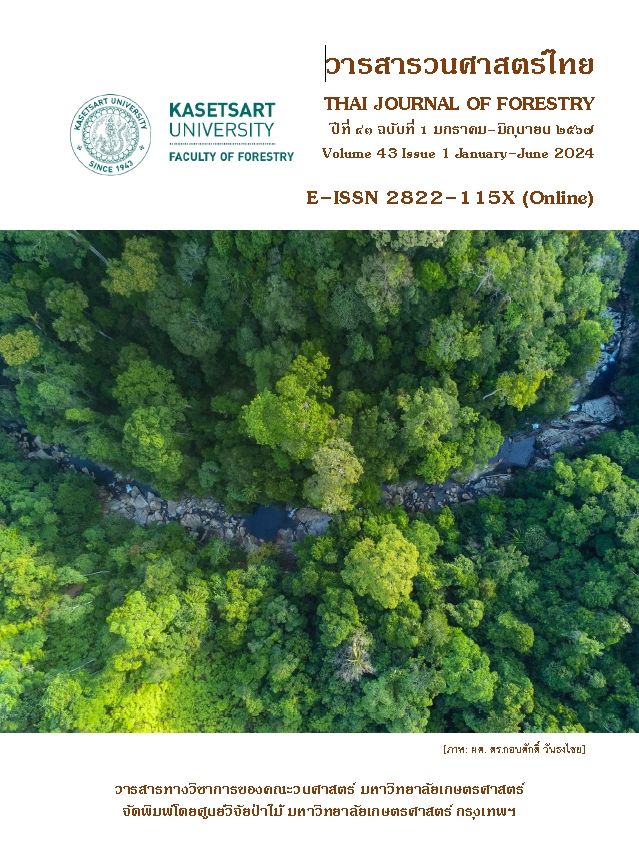ชีววิทยาการสืบพันธุ์ของโมกพะวอ (Wrightia tokiae D.J. Middleton) ในอุทยานแห่งชาติขุนพะวอ จังหวัดตาก
Main Article Content
บทคัดย่อ
ชีววิทยาการสืบพันธุ์ของโมกพะวอ (Wrightia tokiae D.J. Middleton) ได้ศึกษาในพื้นที่อุทยานแห่งชาติขุนพะวอ อำเภอแม่สอด จังหวัดตาก ระหว่างเดือนตุลาคม พ.ศ. 2565 ถึงเดือนกันยายน พ.ศ. 2566 โดยมีวัตถุประสงค์เพื่อศึกษาชีววิทยาและการพัฒนาการของดอก การผสมเกสร อัตราการติดผล และความหลากชนิดของแมลงตอมดอก ซึ่งการสำรวจแมลงใช้วิธีการวางกับดักมุ้งในช่วงที่โมกพะวอกำลังออกดอก ผลการศึกษาพบว่า โมกพะวอเริ่มออกดอกตั้งแต่ปลายเดือนพฤษภาคม และบานไปถึงปลายเดือนมิถุนายน การพัฒนาของดอกโมกพะวอเริ่มตั้งแต่เป็นตาดอก พัฒนาไปเป็นช่อดอกถึงระยะดอกพัฒนาเต็มที่ และบาน ใช้เวลาประมาณ 9-10 วัน ดอกสมบูรณ์เพศ ช่อดอกแบบกระจุก กลีบดอกรูปกงล้อ สีส้มอ่อน ดอกร่วงสีแดงเข้ม เรณูเดี่ยว รูปทรงกลม ค่าเฉลี่ยจำนวนเรณูต่อดอกเท่ากับ 6,633.40±750.50 เรณู ค่าเฉลี่ยจำนวนออวุลต่อดอก 38.60±2.99 ออวุล ค่าอัตราส่วนจำนวนเรณูต่อออวุล มีค่าเฉลี่ยเท่ากับ 170.04±9.58 จัดเป็นระบบผสมข้ามต่ำมีแนวโน้มผสมพันธุ์ในตัวเอง ส่วนการศึกษาอัตราการติดผล พบเฉพาะการผสมแบบเปิดหรือปล่อยให้มีการผสมเกสรตามธรรมชาติ มีอัตราการติดผลร้อยละ 10.24 และการผสมเกสรตัวเอง โดยการคลุมช่อดอกที่ไม่พบการติดผล แสดงให้เห็นว่าโมกพะวอเป็นพืชที่จำเป็นต้องมีพาหะนำเรณูช่วยในการผสมเกสร ส่วนชนิดของแมลงตอมดอกพบเป็นพวกผีเสื้อกลางคืนในอันดับ Lepidoptera จำนวน 20 ชนิด ซึ่งจัดเป็นกลุ่มแมลงตอมดอกที่สำคัญในการช่วยผสมเกสรที่มีพฤติกรรมสัมพันธ์กับการบานของดอกโมกพะวอที่ดอกบานในตอนกลางคืน
Downloads
Article Details

อนุญาตภายใต้เงื่อนไข Creative Commons Attribution-NonCommercial-NoDerivatives 4.0 International License.
ข้าพเจ้าและผู้เขียนร่วม (ถ้ามี) ขอรับรองว่า ต้นฉบับที่เสนอมานี้ยังไม่เคยได้รับการตีพิมพ์และไม่ได้อยู่ในระหว่างกระบวนการพิจารณาตีพิมพ์ลงในวารสารหรือสิ่งตีพิมพ์อื่นใด ข้าพเจ้าและผู้เขียนร่วม (ถ้ามี) ยอมรับหลักเกณฑ์และเงื่อนไขการพิจารณาต้นฉบับ ทั้งยินยอมให้กองบรรณาธิการมีสิทธิ์พิจารณาและตรวจแก้ต้นฉบับได้ตามที่เห็นสมควร พร้อมนี้ขอมอบลิขสิทธิ์ผลงานที่ได้รับการตีพิมพ์ให้แก่วารสารวนศาสตร์ คณะวนศาสตร์ มหาวิทยาลัยเกษตรศาสตร์ กรณีมีการฟ้องร้องเรื่องการละเมิดลิขสิทธิ์เกี่ยวกับภาพ กราฟ ข้อความส่วนใดส่วนหนึ่ง หรือ ข้อคิดเห็นที่ปรากฏในผลงาน ให้เป็นความรับผิดชอบของข้าพเจ้าและผู้เขียนร่วม (ถ้ามี) แต่เพียงฝ่ายเดียว และหากข้าพเจ้าและผู้เขียนร่วม (ถ้ามี) ประสงค์ถอนบทความในระหว่างกระบวนการพิจารณาของทางวารสาร ข้าพเจ้าและผู้เขียนร่วม (ถ้ามี) ยินดีรับผิดชอบค่าใช้จ่ายทั้งหมดที่เกิดขึ้นในกระบวนการพิจารณาบทความนั้น”
เอกสารอ้างอิง
Barman, C., Singh, V.K., Das, S., Tandon, R. 2018. Floral contrivances and specialized pollination mechanism strongly influence mixed mating in Wrightia tomentosa (Apocynaceae). Plant Biology, 20(3): 546-554.
Chelong, I., Aulia, F., Bintari, C.N., Hanum, F.T. 2016. A palynology and classification study of some species in Apocynaceae family at Yala Rajabhat University, Thailand. YRU Journal of Science and Technology, 1(1): 65-73. (in Thai)
Cruden, R.W. 1977. Pollen-ovule ratios: A conservative indicator of breeding systems in flowering plants. Evolution, 31: 32-46.
Darrault, R.O., Schlindwein, C. 2005. Limited fruit production in Hancornia speciosa (Apocynaceae) and pollination by Nocturnal and Diurnal insects. BIOTROPICA, 37(3): 381–388.
Erdtman, G. 1986. Pollen Morphology and Plant Taxonomy Angiosperms (An Introduction to Palynology). Heffner Publishing Company, London, England.
Middleton, D. J. 2010. Three new species of Wrightia Apocynaceae: Apocynoideae) from Thailand. Gardens’ Bulletin Singapore, 61(2): 369-378.
Reisla, O.D., Schlindwein, C. 2005. Limited fruit production in Hancornia speciosa (Apocynaceae) and pollination by Nocturnal and Diurnal insects. BIOTROPICA, 37(3): 381–388.
Santisuk, T. 2004. Endemic and rare plants of Thailand. Agricultural cooperative printing demonstrations of Thai co., Ltd., Bangkok, Thailand. (in Thai)
Tasen, W. 2001. The Role of Some Major Insect Pollinators on Pollination of Teak (Tectona grandis Linn.f.). M.S. Thesis, Kasetsart University, Bangkok, Thailand. (in Thai)
Tasen, W., Tangmitcharoen, S., Thakeaw, M., Chanthep, P., Ogata, K. 2009. Diversity and foraging behavior of insect visitors on pollination of agarwood (Aquilaria crassna Pierre ex Lec.) flowers at Khao Yai National Park. Thai Journal of Forestry, 28(1): 17-28. (in Thai)
Xiong, W., Ollerton, J., Liede-Schumann, S., Zhao, W., Jiang, Q., Sun, H., Liao, W., You, W. 2020. Specialized cockroach pollination in the rare and endangered plant Vincetoxicum hainanense in China. American Journal of Botany, 107(10): 1355-1365.


